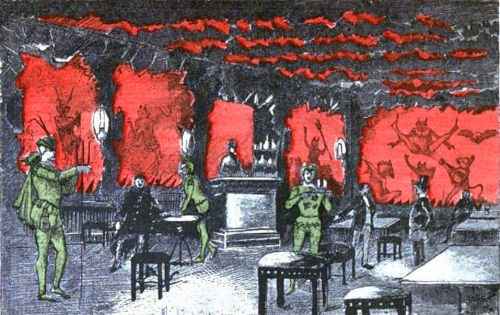
Credit for the development of the first theme restaurants goes to Paris cafés and cabarets which opened in Montmartre in the later nineteenth century. They were primarily drinking spots rather than full-scale restaurants but they served food also. Like American theme restaurants today they were built around a concept and created an environment which appeared to be something other than a mere eating and drinking place.
In their early years these artistic cafés had a counter-cultural impetus that in some cases celebrated the revolutionary Paris Commune of 1871 which had been rooted in Montmartre.
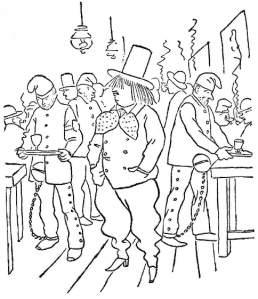 That was particularly true of the Café du Bagne (Café of the Penitentiary) established in 1885 by Maxime Lisbonne (shown with waiters), a member of the Commune long exiled in a South Pacific penal colony. Posters on the wall of his café, which replicated a prison eating hall, hailed Commune heroes. Waiters were dressed as real convicts but with fake balls and chains. The place caused an instant sensation when it opened, with patrons lining up outside to get in. Possessed of a socialistic mission, Lisbonne posted a sign in 1886 announcing a free breakfast for the poor residents of Montmartre: “Come, and eat your fill, your appetite sharpened by the knowledge that it was from their [the capitalists] coffers the money was extracted.”
That was particularly true of the Café du Bagne (Café of the Penitentiary) established in 1885 by Maxime Lisbonne (shown with waiters), a member of the Commune long exiled in a South Pacific penal colony. Posters on the wall of his café, which replicated a prison eating hall, hailed Commune heroes. Waiters were dressed as real convicts but with fake balls and chains. The place caused an instant sensation when it opened, with patrons lining up outside to get in. Possessed of a socialistic mission, Lisbonne posted a sign in 1886 announcing a free breakfast for the poor residents of Montmartre: “Come, and eat your fill, your appetite sharpened by the knowledge that it was from their [the capitalists] coffers the money was extracted.”
The Chateau d’If’ of the 1880s, possibly an imitator of the Café du Bagne, was designed to resemble the prison by the same name in Dumas’s The Count of Monte Cristo. Outside it had an imitation drawbridge which stretched from the street to a large oak door, while inside were cells and dungeons. The L’Abbaye de Thélème, with a medieval theme, dressed its servers as monks and nuns.
At Le Chat Noir, the decor was in Louis XIII style, with waiters dressed in the authentic green jackets of the Immortals of the French Academy whose job it was to protect the purity of the French language – the object being, of course, to mock them. When it was established in 1881, Le Chat Noir, which was also decorated with images of black cats throughout, served as a club for artists where they exhibited their work. Its fame spread quickly and it became a magnet for visitors to Paris. (Later incarnation of Le Chat Noir pictured below.)
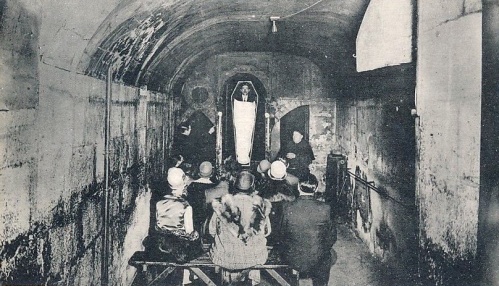
Many of the Montmartre cafés celebrated the macabre, with paintings and decor whose subjects included infanticide, crucifixion, and assassination, but in 1894 The Café of Death opened, furnished with coffins serving as tables. The police objected to its name and its habit of serving beer in imitation human skulls so its name was changed to the Cabaret du Néant [of Nothingness] (see above).
 The 1890s marked a turning point at which original owners left the scene, artists stopped coming, bohemianism vanished, and new café owners took dead aim at tourists. Certainly few of the popular cafés and cabarets of the early 20th century had much connection with earlier enterprises even when old names remained. Many felt that the Café de l’Enfer (Café of Hell) exemplified the purely commercial type of enterprise.
The 1890s marked a turning point at which original owners left the scene, artists stopped coming, bohemianism vanished, and new café owners took dead aim at tourists. Certainly few of the popular cafés and cabarets of the early 20th century had much connection with earlier enterprises even when old names remained. Many felt that the Café de l’Enfer (Café of Hell) exemplified the purely commercial type of enterprise.
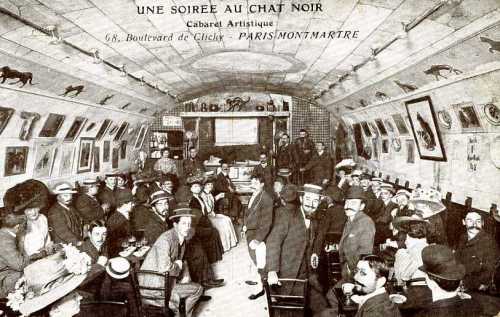
The spirit of Paris’s bohemian cafés passed into the United States first in New York City. Au Chat Noir was in business there in 1895, decorated with a wall frieze of black cats. Otherwise, though, it seemed like a fairly standard small French restaurant of the day serving dishes such as cold lobster, tripe, and deviled crabs. Later at least a couple of other cafés named The Black Cat appeared in NY and Coppa’s in San Francisco adopted a similar theme.
Other early theme restaurants undoubtedly inspired by Paris cafés include beefsteak dungeons in New York and elsewhere, as well as tea rooms and cabarets in Greenwich Village both before and after World War I, a prime example being the Pirates’ Den. As in Paris, theme restaurants and cafés rapidly lost any counter-cultural overtones.
© Jan Whitaker, 2010
 The club – its name suggestive of Paris — seated 600 patrons. It took a lot of effort to fill it Like New York’s other nightclubs of that era, it was highly dependent upon out-of-towners.
The club – its name suggestive of Paris — seated 600 patrons. It took a lot of effort to fill it Like New York’s other nightclubs of that era, it was highly dependent upon out-of-towners. The Latin Quarter opened in 1942, with Lou Walters as manager-owner and E. M. Loew’s of Boston’s Loew’s theaters as a financial backer. Walters (father of Barbara Walters) also had interests in LQ clubs in Boston, Miami, and Detroit, along with other nightclubs in New York and Florida.
The Latin Quarter opened in 1942, with Lou Walters as manager-owner and E. M. Loew’s of Boston’s Loew’s theaters as a financial backer. Walters (father of Barbara Walters) also had interests in LQ clubs in Boston, Miami, and Detroit, along with other nightclubs in New York and Florida. In addition to the nearly nude performers and big name bands and comedy acts, the LQ threw in some trick performances such as a waiter who unexpectedly squirted guests with water and a drunk photographer who would stumble onto the stage taking pictures of performers and creating a noisy ruckus. He was so convincing that guests (and sometimes even waiters) would try to shush him or have him arrested.
In addition to the nearly nude performers and big name bands and comedy acts, the LQ threw in some trick performances such as a waiter who unexpectedly squirted guests with water and a drunk photographer who would stumble onto the stage taking pictures of performers and creating a noisy ruckus. He was so convincing that guests (and sometimes even waiters) would try to shush him or have him arrested.





















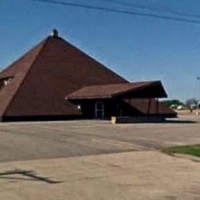

 It's great to hear from readers and I take time to answer queries. I can't always find what you are looking for, but I do appreciate getting thank yous no matter what the outcome.
It's great to hear from readers and I take time to answer queries. I can't always find what you are looking for, but I do appreciate getting thank yous no matter what the outcome.


